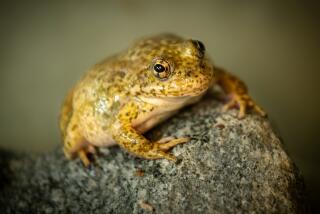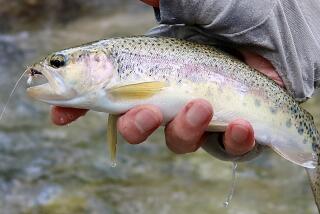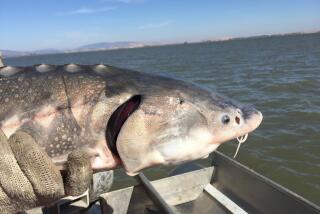Pursuit of Rare Frog Guarantees Wet Feet
SANTA CLARITA VALLEY — The water ripples cold around his knees as Russ Smith sloshes up San Francisquito Canyon creek, parting willows and weeds and peering through binoculars in search of one of California’s rarest creatures.
“There used to be some in here,” he says, scanning every inch of mud beneath a roadway bridge slathered with spray-painted images of hypodermic needles and Nazi symbols. “They must be hiding.”
Smith, curator of reptiles and amphibians at the Los Angeles Zoo, was in his element--scouting in the creek near Magic Mountain for California red-legged frogs, federally designated as a threatened species.
Decimated by hunters, habitat destruction, pesticides, and the appetites of bullfrogs and crayfish, the amphibian made famous by Mark Twain in his “jumping frog” story, once numbered in the millions and occupied a range extending along the coast from Point Reyes south to Baja California.
Today, only about 1,000 are believed to be clinging to existence in creeks and ponds scattered across Southern California, many of them hemmed in by new development. In Riverside County’s sprawling Santa Rosa Plateau Ecological Reserve, where 51,000 acres have been set aside as critical red-legged frog habitat, the total population is composed of two bachelors separated from a lone spinster--last seen two years ago--by a two-lane road.
A tall, lanky biologist with an easy smile, Smith aims to play a pivotal role in repairing such disorders in the red-legged frog’s universe.
Leaning back in a chair in his small office at the zoo, and surrounded by terrariums containing desert hairy scorpions, Madagascan hissing cockroaches and Vietnamese walking sticks, he recently explained his goals.
“My dream is the first major frog reintroduction program in United States history, which would include breeding stock, and a head start program at the zoo, where we’d raise tadpoles for a year then release them in areas where they used to be found,” Smith said.
And why not? “We’re not talking about a California condor, which lays one egg every other year,” he said. “A female red-legged frog lays about 20,000 eggs at a time.”
Backed by the U.S. Fish and Wildlife Service, the proposal is already underway. A test of the breeding stock is planned for the Riverside reserve, where federal biologists a year ago discovered a genetic match between its two bachelors and a batch of red-legged frogs discovered in a stream 130 miles south of Ensenada in Baja California.
Now, the USFWS, the Nature Conservancy, UC Davis and Smith are providing their Mexican counterparts with information needed to issue permits that would allow them to capture some frogs and transport them across the U.S.-Mexico border.
The first transplants could arrive this spring, according to Smith, who has spent months ridding the Santa Rosa Plateau reserve’s ponds of omnivorous bullfrogs. Within a year, the reserve could conceivably be dispatching thousands of frogs to former haunts in the Tehachapi, Santa Monica and San Gabriel mountains.
“The plan is going to work,” he said. “It might be a slow start. But it will work.”
Some biologists just hope it’s not too late. Santa Rosa’s female hasn’t been spotted in years. Beyond that, the red-legged frog’s life span is about 10 years, meaning the reserve’s males are probably nearing the end of their lives.
But Smith is adamant he will find her, and when he does, “I’ll catch her with a net, put her in a bag and walk her across the road. Then I’ll hope that the frogs do what they’re supposed to.”
Santa Rosa reserve manager Carole Bell put it another way: “A true modern love story would be to bring the woman of their dreams back to the bachelors in that pond.
“If anyone can do it, Russ can,” she added. “With Russ’ enthusiasm and the support of the Los Angeles Zoo, we’re going to get our red-legged frog population back.”
Smith, 56, grew up in the San Fernando Valley and graduated from Cal State Northridge with a degree in biology. He went on to join the Los Angeles Zoo as an animal keeper in 1971, and then worked his way up the ranks to principal animal keeper and curator of reptiles and amphibians.
As a youth, he caught red-legged frogs in Topanga Canyon. In the mid-1980s, he was part of a “zoo consortium” that traveled to New Guinea on three separate occasions to rescue birds of paradise and reptiles from being destroyed by the mining and timber industries.
These days, Smith spends at least seven days each month--and most moonless nights--wading through ponds with binoculars and flashlights, seeking potentially prime frog real estate, and as yet undetected populations of the largest native frog in the western United States.
Forcing his body through a wall of brush and nettles guarding San Francisquito Canyon creek, Smith says: “I love doing this kind of stuff--especially at night.”
“When you wade through a stream in the night with a flashlight, you see hundreds of eyes staring back at you--even spiders have eyeshine,” he says. “Frog eyeshine stands out because of the size of their eyes.”
Rattlesnakes and poison oak, however, also go with the territory. “Once, I was wading along a creek rimmed with tons of poison oak, and my light went out. I pulled out my trusty spare, and it flickered out too. I let my eyes adjust as best they could, then just pushed through all that poison oak,” he recalls. He wound up with a severe rash on both hands.
On a recent weekday, after two hours of scouring that Santa Clarita Valley creek, Smith was ready to call it quits for now.
“I’m going to give it one more look,” he says raising his binoculars to his eyes and surveying the weedy stream bank littered with beer cans, car bumpers and chunks of Styrofoam.
“Yeah, it’s just a frog. I get a personal satisfaction out of spotting these little guys.”
“Nothing,” he mutters after several minutes. “Oh well, I’ll give it another try in February. After dark.”



